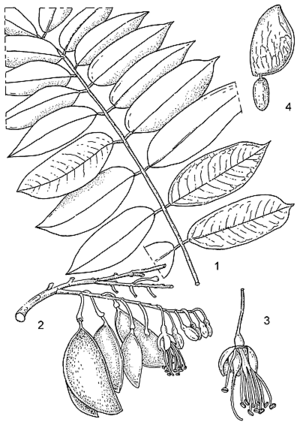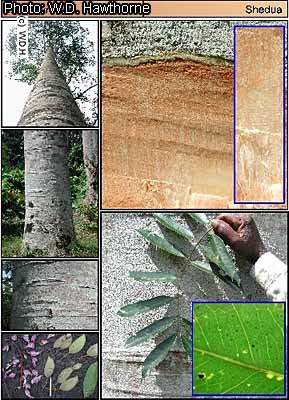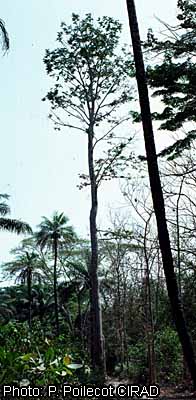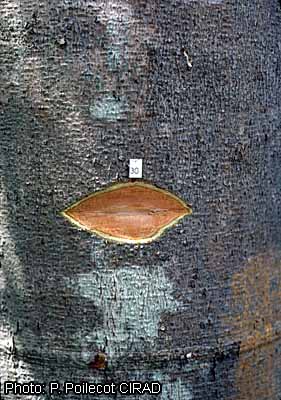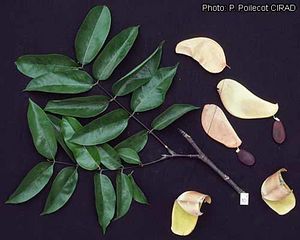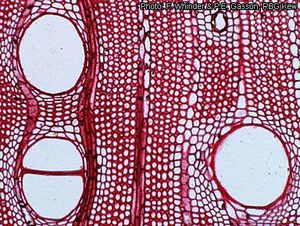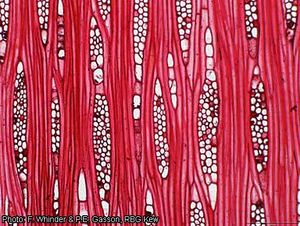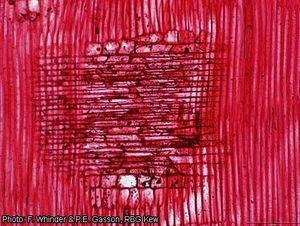Daniellia ogea (PROTA)
Introduction |
| General importance | |
| Geographic coverage Africa | |
| Geographic coverage World | |
| Essential oil / exudate | |
| Medicinal | |
| Timber | |
| Ornamental | |
| Auxiliary plant | |
| Fibre | |
Daniellia ogea (Harms) Rolfe ex Holland
- Protologue: Bull. Misc. Inform. Kew, addit. ser. 9: 268 (1911).
- Family: Caesalpiniaceae (Leguminosae - Caesalpinioideae)
Vernacular names
- Accra copal, Benin gum copal, gum copal tree (En).
- Arbre à encens, faro d’Agboville (Fr).
- Incenso (Po).
Origin and geographic distribution
Daniellia ogea occurs in West and Central Africa, from Senegal east to Cameroon and south to Gabon.
Uses
The wood, traded as ‘faro’, ‘ogea’ or ‘daniellia’, is suitable for light construction, light flooring, joinery, furniture, toys, novelties, boxes, crates, agricultural implements, vats, draining boards, veneer, plywood, hardboard and particle board. It can be used for paper making, and is suitable for firewood and charcoal production.
The quantity of gum, known as ‘aguja gum’ or ‘gum copal’, in the wood is limited and commercial tapping has not been successful. The gum is used in cosmetics, to scent clothes and fumigate huts, and also for medico-magical treatments. It is used to repair broken pottery by placing it along the broken edges and setting fire to it to make the reparation stronger. It is also used as varnish. The gum, mixed with soot and oil, is burnt and is used for tattooing. In Senegal the gum is applied to skin complaints. In Ghana the gum, pounded together with a seed of Dioclea reflexa Hook.f. and some kaolin, is taken in water to treat cough and asthma. The gum is also applied to Buruli ulcers, caused by Mycobacterium ulcerans. In Benin leaf infusions are taken to treat dysentery. In Ghana and Nigeria root decoctions or macerations are taken to treat malaria and gonorrhoea. The gum is chewed as a purgative and together with other ingredients applied to snakebites. In Nigeria the seeds are considered edible.
Production and international trade
In 1983 Côte d’Ivoire exported 73,000 m³ of logs of faro (Daniellia spp.). Currently Daniellia ogea and other Daniellia spp. have no importance on the international timber market, but their wood is commonly used locally.
In 1876 one of the first exports of 500 t gum copal was made from Ghana to Europe. Lumps of gum copal are still sold in local markets, although they are often contaminated with soil.
Properties
The heartwood is pale pinkish brown to reddish brown with dark streaks, and is distinctly demarcated from the up to 15 cm wide, whitish or pale yellow resinous sapwood. The grain is interlocked, texture medium coarse. The wood is scented and has a lustrous surface.
The wood is lightweight to medium-weight, with a density of about 515 kg/m³ at 12% moisture content, moderately soft but tough and of medium strength. The shrinkage rates are moderate, from green to oven dry about 2.6% radial and 5.6–8.2% tangential. Kiln drying is fairly fast with little degrade. In thick boards, there might be slight distortion and collapse, but the defects are not severe. At 12% moisture content, the modulus of rupture is 77–84 N/mm², modulus of elasticity 8820–9700 N/mm², compression parallel to grain 40–47 N/mm², shear 7–11 N/mm², Janka side hardness 3160 N and Janka end hardness 4310 N.
The wood is easy to work with both hand and machine tools, with little blunting effect on cutting edges. Although the wood planes smoothly, tearing of quarter-sawn surfaces may occur due to interlocked grain, and thin, sharp cutting edges are more useful in obtaining a good finish than a reduced cutting angle. The wood stains satisfactorily but needs a filler before polishing. It nails well and glues correctly. It can be readily peeled into veneer. The steam bending properties are very poor. The wood is not durable, being susceptible to attacks by fungi, borers, termites, pinhole borers, Lyctus, longhorn beetles and marine borers. The heartwood and inner sapwood are moderately resistant to impregnation, but the outer sapwood is easy to treat with preservatives. The cellulose content of the wood is 46–48%. The wood fibres are strong and about 1.5 mm long.
The gum from the heartwood is dark brown, oily and sticky, and can be saponified, although it has a low saponification value. One of the main compounds of the exudate is the diterpene oleoresin daniellic acid (illurinic acid), as well as ozoic acid and the alcohol ozol. Chemical analyses revealed that the gum contained 6.0% water, 1.3% protein, 13.0% fat, 42.8% crude fibre and 2.0% ash. It had 8.0% foaming capacity, and oil and water absorption capacity were 12.0% and 24.3%, respectively.
The seed contains low levels of protein (10.1%) and fat, but high levels of total carbohydrate (74%) and minerals. It contains much of the amino acid cysteine. The seed oil contains high amounts of linoleic acid (27.7%), followed by lignoceric acid (9.2%), palmitic acid (7.5%), oleic acid (6.6%) and behenic acid (3.3%).
A range of sesquiterpenoids were isolated from the leaf oil, with as main component caryophyllene oxide (20.1%), followed by humulene oxide (7.0%), α-humulene (3.8%) and β-selinene (3.8%).
Adulterations and substitutes
The wood of Daniellia ogea is similar to that of Daniellia thurifera Benn. and Daniellia klainei Pierre ex A.Chev. and has similar uses.
Description
- Deciduous, medium-sized to large tree up to 40(–50) m tall; bole straight and cylindrical, up to 125 cm in diameter, without buttresses; bark surface smooth, greyish white to greenish grey, with elongated horizontal patches in various colours, inner bark thick, hard, fibrous, pinkish brown with fine lines; crown rather small, flattened.
- Leaves alternate, paripinnately compound with 5–9 pairs of leaflets; stipules up to 8.5 cm long, soon falling; petiole 2–4(–4.5) cm long, rachis (11–)15–24(–27) cm long, shallowly channelled at base, quadrangular at apex, with a pair of glands at insertion of basal pair of leaflets; petiolules 3–9 mm long; leaflets opposite, elliptical-lanceolate to lanceolate, up to 11(–15) cm × 4 cm, basal and apical leaflets smaller than middle ones, base cuneate to rounded, asymmetrical, apex acuminate, margins entire, papery to leathery, glabrous, with many translucent glandular dots, pinnately veined with 8–16 pairs of lateral veins. Inflorescence an axillary or terminal compound raceme (7–)15–20(–22) cm long, densely woolly hairy, with 5–12 lateral branches.
- Flowers bisexual, zygomorphic; pedicel 9–15(–17) mm long, glabrous, enlarging in fruit, near the middle with 2 caducous bracteoles 0.5–1 cm long; sepals 4, oblong, 1–1.5(–2) cm long, short-hairy, with gland dots on external surface; petals 5, blue to lilac, unequal, oblong to oblong-elliptical or oblong-lanceolate, 3 petals 0.5–1(–1.5) cm long and 2 up to 0.2 cm long, glabrous to short-hairy; stamens 10, 2–3(–3.5) cm long, 9 united at base and 1 free; ovary superior, oblong to rounded, c. 0.5 cm long, densely woolly hairy, with stipe 0.5–1 cm long, style 1.5–2(–3) cm long.
- Fruit an obliquely oblong, flattened pod 6–7(–9) cm × 2.5–3.5(–5) cm, with stipe 0.5–1 cm long, densely short-hairy mainly at margin, green becoming brown, dehiscing with 2 woody valves, 1-seeded.
- Seed oblong, flattened, c. 3 cm long, smooth, dark brown, attached to one of the valves by a c. 1.5 cm long funicle.
- Seedling with epigeal germination; hypocotyl c. 9 cm long, epicotyl c. 6 cm long, glabrous; cotyledons fleshy, c. 2.5 cm long, rounded; first leaves alternate, with 1–2 pairs of leaflets.
Other botanical information
Daniellia comprises 10 species, which are nearly all confined to the forest areas of West and Central Africa, with only 1 species extending to Sudan and Uganda.
Anatomy
Wood-anatomical description (IAWA hardwood codes):
- Growth rings: 2: growth ring boundaries indistinct or absent.
- Vessels: 5: wood diffuse-porous; 13: simple perforation plates; 22: intervessel pits alternate; 23: shape of alternate pits polygonal; (26: intervessel pits medium (7–10 μm)); 27: intervessel pits large (≥ 10 μm); 29: vestured pits; 30: vessel-ray pits with distinct borders; similar to intervessel pits in size and shape throughout the ray cell; 43: mean tangential diameter of vessel lumina ≥ 200 μm; 46: ≤ 5 vessels per square millimetre; 58: gums and other deposits in heartwood vessels.
- Tracheids and fibres: 61: fibres with simple to minutely bordered pits; 66: non-septate fibres present; (68: fibres very thin-walled); 69: fibres thin- to thick-walled.
- Axial parenchyma: 78: axial parenchyma scanty paratracheal; 79: axial parenchyma vasicentric; (89: axial parenchyma in marginal or in seemingly marginal bands); 91: two cells per parenchyma strand; (92: four (3–4) cells per parenchyma strand).
- Rays: 97: ray width 1–3 cells; 98: larger rays commonly 4- to 10-seriate; 106: body ray cells procumbent with one row of upright and/or square marginal cells; (107: body ray cells procumbent with mostly 2–4 rows of upright and/or square marginal cells); 115: 4–12 rays per mm.
- Storied structure: 118: all rays storied; 120: axial parenchyma and/or vessel elements storied; 121: fibres storied.
- Secretory elements and cambial variants: 129: axial canals diffuse.
- Mineral inclusions: 136: prismatic crystals present; 142: prismatic crystals in chambered axial parenchyma cells.
Growth and development
Daniellia ogea is considered a pioneer, and seedlings of more than 50 cm tall are light demanding and found in forest gaps. The tree usually sheds its leaves at the end of the rainy season, and flowering occurs when the tree is leafless. Daniellia ogea has been found flowering from September to May and fruiting from November to March.
Ecology
Daniellia ogea occurs in evergreen and semi-deciduous forest, also in swampy localities near water courses, from sea-level up to 800 m altitude. In Nigeria it occurs in old tree plantations after felling of the plantation trees.
Management
In forest management, there is generally no focus on Daniellia ogea because it is not a preferred timber tree. In Sierra Leone the average density of trees with a bole diameter of more than 60 cm has been estimated to be 0.06 per ha.
Harvesting
The minimum bole diameter allowed for harvesting is 60 cm in Côte d’Ivoire and Cameroon, 70 cm in Liberia and 90 cm in Ghana.
Yield
In Sierra Leone it has been reported that trees with a bole diameter of 90–100 cm yield 6–9 m³ of usable wood.
Handling after harvest
Cross-breaks may occur near the heart of the bole. Logs should be processed quickly after felling or treated with preservatives because the wood is susceptible to discoloration by blue-stain fungi and attacks by insects.
Genetic resources
Daniellia ogea has a large area of distribution, but occurs sparsely. However, it does not seem to be threatened by genetic erosion as its wood is generally mainly locally used and not subject to commercial exploitation. Seeds are stored at the IITA Gene bank.
Prospects
Daniellia ogea has not been considered a timber tree of commercial importance because its wood is susceptible to fungal attacks. However, the wood may have good prospects for the production of veneer and plywood by rotary peeling. More information is needed on growth rates and methods to improve regeneration to be able to draw conclusions about possibilities for sustainable exploitation from natural forest. Further research of the exudate is needed on the possible usage in the varnish and cosmetic industry.
Major references
- Asekun, O.T. Ekundayo, O., 2004. The leaf oil of Daniellia ogea L. Journal of essential oil research 16(4): 282–283.
- Bolza, E. & Keating, W.G., 1972. African timbers: the properties, uses and characteristics of 700 species. Division of Building Research, CSIRO, Melbourne, Australia. 710 pp.
- Burkill, H.M., 1995. The useful plants of West Tropical Africa. 2nd Edition. Volume 3, Families J–L. Royal Botanic Gardens, Kew, Richmond, United Kingdom. 857 pp.
- de la Estrella, M., Aedo, C., Mackinder, B. & Velayos, M., 2010. Taxonomic revision of Daniellia (Leguminosae: Caesalpinioideae). Systematic Botany 35(2): 296–324.
- Ezeagu, I.E., Petzke, K.J., Lange, E. & Metges, C.C., 1998. Fat content and fatty acid composition of oils extracted from selected wild-gathered tropical plant seeds from Nigeria. Journal of the American Oil Chemists’ Society 75(8): 1031–1035.
- Ezeagu, I.E., Petzke, J.K., Metges, C.C., Akinsoyinu, A.O. & Ologhobo, A.D., 2002. Seed protein contents and nitrogen-to-protein conversion factors for some uncultivated tropical plant seeds. Food Chemistry 78: 105–109.
- Neuwinger, H.D., 2000. African traditional medicine: a dictionary of plant use and applications. Medpharm Scientific, Stuttgart, Germany. 589 pp.
- Oteng-Amoako, A.A. (Editor), 2006. 100 tropical African timber trees from Ghana: tree description and wood identification with notes on distribution, ecology, silviculture, ethnobotany and wood uses. 304 pp.
- Takahashi, A., 1978. Compilation of data on the mechanical properties of foreign woods (part 3) Africa. Shimane University, Matsue, Japan. 248 pp.
Other references
- Abbiw, D.K., 1990. Useful plants of Ghana: West African uses of wild and cultivated plants. Intermediate Technology Publications, London and Royal Botanic Gardens, Kew, Richmond, United Kingdom. 337 pp.
- Ahonkhai, S.I., 1988. Chemical characterisation of the ashes of some African hardwoods. Wood Science and Technology 22(3): 227–229.
- Ajibesin, K.K., Ekpo, B.A., Bala, D.N., Essien, E.E. & Adesanya, S.A., 2008. Ethnobotanical survey of Akwa Ibom State of Nigeria. Journal of Ethnopharmacology 115: 387–408.
- Allabi, A.C., Busia, K., Ekanmian, V. & Bakiono, F., 2011. The use of medicinal plants in self-care in the Agonlin region of Benin. Journal of Ethnopharmacology 133: 234–243.
- Bevan, C.W.L., Ekong, D.E.U. & Okogun, J.I., 1968. West African timbers. Part 21. Extractives from Daniellia species. The structure of a new diterpene, ozic acid. Journal of the Chemical Society C: Organic 1968: 1063–1066.
- CTFT (Centre Technique Forestier Tropical), 1955. Fiche botanique, forestière, industrielle et commerciale: Faro (Daniellia spp.). Bois et Forêts des Tropiques 44: 17–20.
- de la Estrella, M., Aedo, C. & Velayos, M., 2009. A morphometric analysis of Daniellia (Fabaceae - Caesalpinioideae). Botanical Journal of the Linnean Society 159(2): 268–279.
- Ezeagu, I.E., 2005. Survey of nutritionally important minerals in some wild underutilized tropical plant seeds. Global Journal of Pure and Applied Sciences 11(3): 403–406.
- Ezeagu, I.E., Metges, C.C., Proll, J., Petzke, K. & Akinsoyinu, A.O., 1996. Chemical composition and nutritive value of some wild-gathered tropical plant seeds. Food and Nutrition Bulletin 17(3): 275–278.
- Gérard, J., Edi Kouassi, A., Daigremont, C., Détienne, P., Fouquet, D. & Vernay, M., 1998. Synthèse sur les caractéristiques technologiques des principaux bois commerciaux africains. Document Forafri 11. Cirad, Montpellier, France. 185 pp.
- Hawthorne, W.D., 1995. Ecological profiles of Ghanaian forest trees. Tropical Forestry Papers 29. Oxford Forestry Institute, Department of Plant Sciences, University of Oxford, United Kingdom. 345 pp.
- Hawthorne, W. & Jongkind, C., 2006. Woody plants of western African forests: a guide to the forest trees, shrubs and lianes from Senegal to Ghana. Kew Publishing, Royal Botanic Gardens, Kew, United Kingdom. 1023 pp.
- Keay, R.W.J., 1989. Trees of Nigeria. A revised version of Nigerian trees (1960, 1964) by Keay, R.W.J., Onochie, C.F.A. & Stanfield, D.P. Clarendon Press, Oxford, United Kingdom. 476 pp.
- Oladipo, G.O., 2005. Nutritional value of Daniellia ogea exudate gum (Ojia). BSc Chemistry degree thesis, Department of Chemistry, College of Natural Sciences, University of Agriculture, Abeokuta, Nigeria. 42 pp.
- Petzke, K.J., Ezeagu, I.E., Proll, J., Akinsoyinu, A.O. & Metges, C.C., 1997. Amino acid composition, available lysine content and in vitro protein digestibility of selected tropical crop seeds. Plant Foods for Human Nutrition 50: 151–162.
- Sandermann, W., Ehlers, R.C. & Feht, F., 1963. Bois tropicaux à résine. Bois et Forêts des Tropiques 88: 43–55.
- Savill, P.S. & Fox, J.E.D., 1967. Trees of Sierra Leone. Forest Department, Freetown, Sierra Leone. 316 pp.
Sources of illustration
- Voorhoeve, A.G., 1965. Liberian high forest trees. A systematic botanical study of the 75 most important or frequent high forest trees, with reference to numerous related species. Pudoc, Wageningen, Netherlands. 416 pp.
Author(s)
- G.H. Schmelzer, PROTA Network Office Europe, Wageningen University, P.O. Box 341, 6700 AH Wageningen, Netherlands
Correct citation of this article
Schmelzer, G.H., 2012. Daniellia ogea (Harms) Rolfe ex Holland. [Internet] Record from PROTA4U. Lemmens, R.H.M.J., Louppe, D. & Oteng-Amoako, A.A. (Editors). PROTA (Plant Resources of Tropical Africa / Ressources végétales de l’Afrique tropicale), Wageningen, Netherlands.
Accessed 18 December 2024.
- See the Prota4U database.


